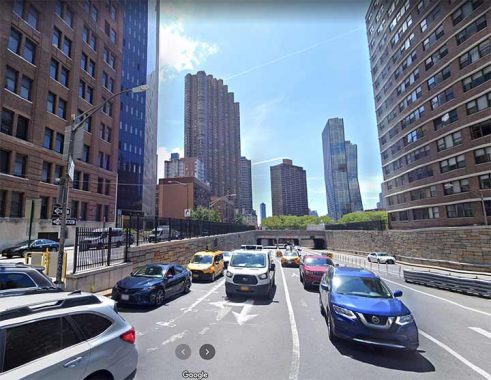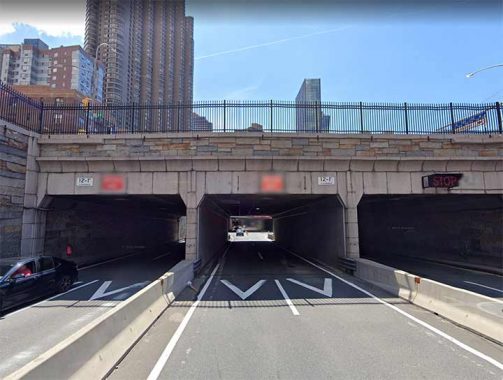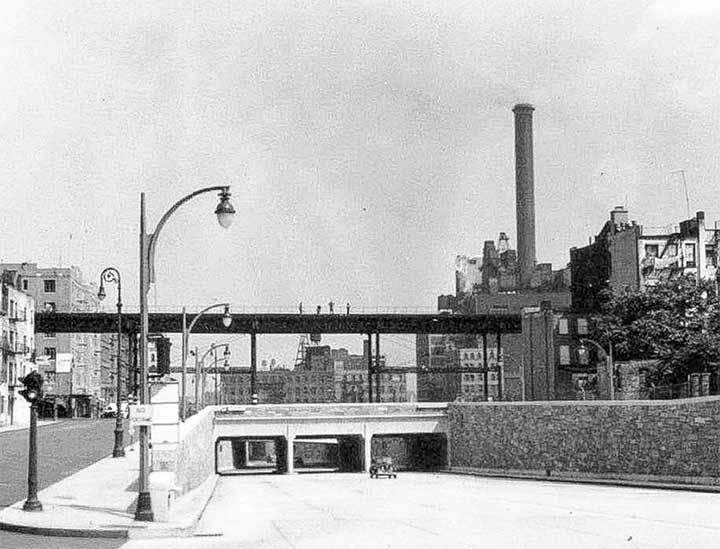
HERE’S a look at the westbound exit ramp of the Queens-Midtown tunnel the year it opened, in 1940. To an infrastructure buff, there are several interesting things going on here. From the beginning, the tunnel and its entrance and exit ramps have had their own peculiar style of curved-mast lampposts, and they still stand guard on the entrance and exit roads labeled on maps as “Tunnel Entrance Street” “Tunnel Approach Street” and “Tunnel Exit Street.” However, this is the first photo I’ve seen that shows what the original lamp fixtures looked like; in the 1950s they were replaced by Westinghouse AK-10 cuplights that have recently been given bright white LED bulbs.
The elevated train in the background was the Second Avenue El, which had only two years of operations left when the photo was taken.

Here’s a look today from approximately the same spot. There’s quite a bit more traffic these days, and a lot more high rise apartment buildings, the most distinctive of which is The Corinthian, seen center left.

Take a look at the 1940 photo again. Care was taken to make the tunnel walls and overpasses especially pleasing with attractive brickwork. Most of this has been retained in the 2nd Avenue and Tunnel Approach Street overpasses south of the tunnel bellmouth. I’ve been talking about hidden tunnels lately, and these overpasses are sufficiently wide to give the impressions of a pair of short tunnels after traffic has emerged from the QMT proper.
As always, “comment…as you see fit.” I earn a small payment when you click on any ad on the site.
1/3/22


5 comments
If you look to the lamp post on the left in the google maps shot, you’ll see another ‘forgotten’ light. I speak of a Crouse Hinds single section 12″ red traffic light. Nick named ‘art deco’ for it’s design with fins and body design. Serving as an adjunct to the Do Not Enter sign, it was most likely a flashing beacon. It appears it was functional until 2014 (based on google maps time travel) unless subsequent captures caught it in the off mode. Most of the city’s early traffic light demands were served by Ruleta, Horni, GE, Signal Service Corporation and later Marbelite (who absorbed all previous brands except GE). While I am far from well versed in NYC traffic signals, the only time I’ve seen deco signals used was on the Tri-boro bridge set up as lane control from the East River Drive to the outbound TBB as well as yellow warning beacons. Regarding the Queens Midtown Tunnel, there was, prior to cashless tolling installation, a Crouse Hinds Type M on the out bound entrance walls (right lane) and apparently the TBTA had a thing for Crouse as early tollbooth installations also sported deco lane control signals on the Throggs Neck plaza and White Stone as well. Sadly those have been lost to cashless tolling. Thanks for entertaining my ramblings.
The Q-M Tunnel opened Nov. 15, 1940, and the 2nd Ave. el closed June 13, 1942 – so the scene shown was only there for about a year and a half. The exit at the extreme left bottom corner allows traffic to access E. 37th St. just east of 3rd Ave., where there was an elevated line that ran until May 12, 1955. That exit is still in use.
Great photo, thanks for posting. The almost complete absence of motor traffic exiting the QMT is probably due to World War II’s fuel and rubber rationing.
I agree that the decorative brickwork is quite attractive and has thankfully been retained. I always considered those bricks a signature feature of the QMT.
They had rationing in the US a year before the countryentered the war?
No, they didn’t. Photo was probably taken on a Sunday morning, and there were much fewer autos in NYC in general in 1940. And much like today, many drivers likely skipped the tunnel toll by using the nearby 59th Street Bridge instead. No war rationing in 1940 though.
Used to work for a company that owned a floor near top of the Corinthian, and they would let employees stay at one of the apartments if we couldn’t get home/got snowed in at work, etc. I worked in Security Ops for the company and would often work crazy hours with short turnarounds, so I slept there a few times. The WINDIEST apartments I ever stayed in, which wasn’t surprising as they are 50 floors up and right near the East River.